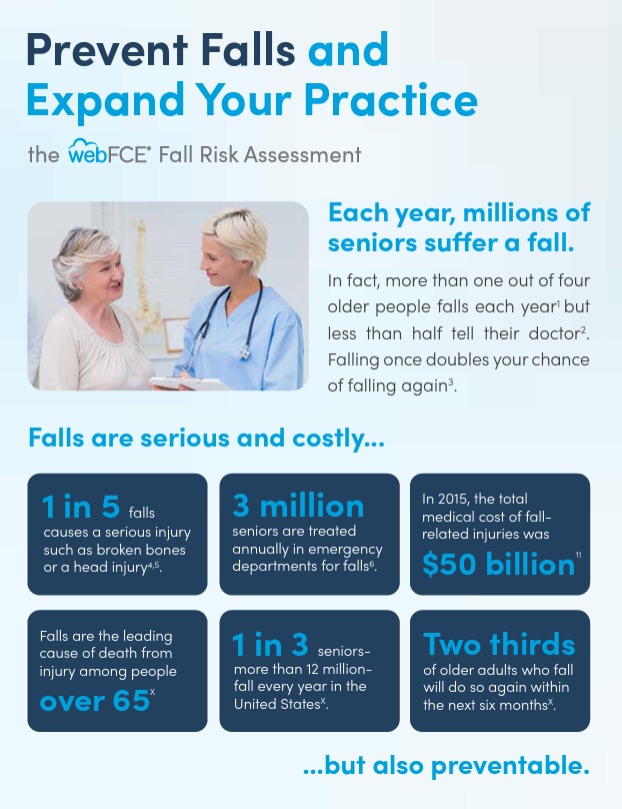Fall Statistics:
- Each year, millions of older people—those 65 and older—fall. In fact, more than one out of four older people falls each year (1) but less than half tell their doctor.(2) Falling once doubles your chances of falling again. (3)
- According to the National Council on Aging statistics, every 11 seconds an older adult is treated in the emergency room for a fall.
- 1 in 3 older adults- about 12 million- fall every year in the U.S.
- Over ½ of all falls take place at home.
- More than 80,000 people a year are sent to the hospital for falls due to pets.
- When an elderly person falls, their hospital stays are almost twice longer than those of elderly patients who are admitted for any other reason.
- One out of five falls causes a serious injury such as broken bones or a head injury,4,5
- Each year, 3 million older people are treated in emergency departments for fall injuries.6
- Over 800,000 patients a year are hospitalized because of a fall injury, most often because of a head injury or hip fracture. 6
- Each year at least 300,000 older people are hospitalized for hip fractures.7
- More than 95% of hip fractures are caused by falling,8 usually by falling sideways.9
- Falls are the most common cause of traumatic brain injuries (TBI).10
- Falls are the leading cause of death from injury among people 65 and older.
- In 2015, the total medical costs for falls totaled more than $50 billion.11 Medicare and Medicaid shouldered 75% of these costs.
- Approximately 9,500 deaths in older Americans are associated with falls each year.
- One-fourth of seniors who fracture a hip from a fall will die within six months of the injury.
- About ½ to up to ¾ of all adults living in long-term care settings suffer a fall each. This rate is twice as large as the rate of falls which occur for elders living in a community.
- Injuries from falls account for roughly 36 percent of potentially preventable visits to the hospital emergency room by nursing home patients.
- Between 16 percent and 27 percent of nursing home falls occur due to environmental hazards such as inadequate lighting or slippery floors within nursing homes.
- The CDC (U.S. Centers for Disease Control and Prevention) receives between 100 and 200 reports of nursing home falls each year from average-sized (approx. 100 beds for elder residence) nursing homes.
- Nursing home falls frequently cause a disability, functional decline, reduced independence, and reduced quality of life for an elderly person. Patients with a fear of nursing home falls may also experience feelings of helplessness, loss of function, depression, anxiety, and social isolation. It is important to take precautions both in and out of a nursing home facility to prevent elderly falls, fractures and injury.

Cost of a Fall in a Healthcare Facility:
- Physical and psychological harm to your patient
- Further treatment beyond the original complaint, taking up time and resources that could have been better spent elsewhere.
- Hospitals needing to bear the full medical cost of a preventable fall.
- Expensive litigation and the ensuing damage to your reputation.
- Loss of Medicare/Medicaid funding.
- Loss of your right to provide healthcare services.

References:
- Bergen G, Stevens MR, Burns ER. Falls and Fall Injuries Among Adults Aged ≥65 Years — United States, 2014. MMWR Morb Mortal Wkly Rep 2016;65:993–998.
- Stevens JA, Ballesteros MF, Mack KA, Rudd RA, DeCaro E, Adler G. Gender differences in seeking care for falls in the aged Medicare Population. Am J Prev Med 2012;43:59–62.
- O’Loughlin J et al. Incidence of and risk factors for falls and injurious falls among the community-dwelling elderly. American journal of epidemiology, 1993, 137:342-54.
- Alexander BH, Rivara FP, Wolf ME. The cost and frequency of hospitalization for fall–related injuries in older adults. American Journal of Public Health 1992;82(7):1020–3.
- Sterling DA, O’Connor JA, Bonadies J. Geriatric falls: injury severity is high and disproportionate to mechanism. Journal of Trauma–Injury, Infection and Critical Care 2001;50(1):116–9.
- Centers for Disease Control and Prevention, National Center for Injury Prevention and Control. Web–based Injury Statistics Query and Reporting System (WISQARS) [online]. Accessed August 5, 2016.
- Healthcare Cost and Utilization Project (HCUP). 2012. Agency for Healthcare Research and Quality, Rockville, MD. http://hcupnet.ahrq.govexternal icon. Accessed 5 August 2016.
- Hayes WC, Myers ER, Morris JN, Gerhart TN, Yett HS, Lipsitz LA. Impact near the hip dominates fracture risk in elderly nursing home residents who fall. Calcif Tissue Int 1993;52:192-198.